Do you have it too — that tingling sensation, that impatience, the desire to finally dig your hands in the soil again and, above all, to sit outside on the balcony? We won’t be sitting outside yet, but we will be dreaming in anticipation of spring, reading up, planning the balcony year and we can also harvest — inside and outside. In the following article “Balcony in February”, you can read about what can be sown and planted for the balcony in February, what tasks need to be done and what can be harvested.
On the (deviating) sowing dates
Just as the information on the seed packets and seed suppliers’ websites varies, so do the sowing calendars of seed suppliers and gardeners’ websites. Regional conditions are different everywhere and experiences vary. Our balconies in the cities have even more different conditions due to the heat of the city and radiating house walls. Here too, it is important to COURAGEOUSLY, PLAYFULLY and EXPERIMENTALLY gather your own experience and SEED. The seed itself ultimately decides after sowing whether the conditions of light, water and temperature appear favorable for germination or not until later.
Good information on sowing dates and conditions at:
- Bingenheim seeds, special page Current seeds in February — what can I sow now?
- Janet Glausch Natural garden seeds from Leipzig Special page — what can I sow now in February?
- Templin herb garden
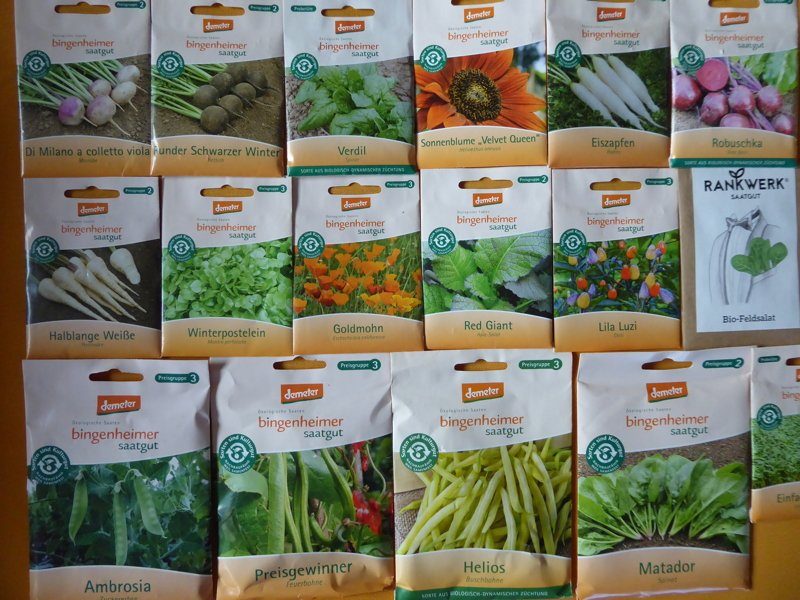
In February, seeds can be sown for growing vegetables on the balcony:
- Asian salads can be sown indoors in pre-cultivation, but can also be sown outdoors in balcony boxes from mid-February, Asian salad mix as a simple seed disc
- Batavia lettuce “American brown” (particularly suitable for baby leaf cultivation)
- Chili (Vorkultur, aber nur mit Unterstützung von Beleuchtung), besonders schön mit lila Blättern und dreifarbigen Früchten sind Lila Luziin red: Bell peppers
- Kohlrabi (preculture), recommendation blue: Blaro, Azur Starwhite: Orinoco
- Paprika (pre-cultivation), proven balcony variety in red: Candy apple, Fritzin orange: Flynnin yellow: Radja
- Radishrecommendations for the tub: Sora, Rudi, Icicle, French Breakfast2
- early lettuce May King
- Physalis (Andean berry, Cape gooseberry) Schoenbrunn gold + Physalis Preciosa (pineapple cherry, tomatillo): End of February/March in preculture
- Eggplant (preculture)
- Pea sprouts
- Field beans
- Topinambur stick — simply a single tuber from the organic market in a bucket-sized bucket or larger
- Garlic stick, who missed it in the fall, but they get less big
- Winter in particular is the right time for growing Microgreens and sprouts on the kitchen table and windowsill
- There may well still be Winter vegetable young plants (Asia-Salate, Wilde Rauke, Hirschhornwegerich, Mangold, …) gesetzt werden (5 % Rabatt-Code Organic balcony5)
It’s still too early for tomatoes, they grow too quickly due to the poor light conditions and grow horny, i.e. not strong and compact. It really is a good idea to sow the majority of tomatoes in mid/end March and wait until then. However, sowing one or two plants towards the end of February can be a good way to get some early tomatoes. Most plants grow better by sowing later because there is more light available. In February, light conditions are still unfavorable due to a combination of short days and low sun. Seeds need plenty of light to grow healthily, so it can be difficult to grow healthy seedlings indoors where light conditions are still less favorable than outdoors. Place the seeds on the brightest windowsill you have. If you don’t manage to grow strong, robust plants from seeds sown in February, try later in the year and the plants will catch up, or invest in a good quality LED grow light. Another option, of course, is to simply buy chilies and eggplants as young plants later in the year.

Extra tip for peppers and chili
Chili expert Alexander Hicks recommends the Sowing peppers and chili peppers for mid-February:
Opinions differ greatly on this. Many chili friends say that you have to cultivate them as perennials, i.e. start sowing in October or November so that you can get fruit relatively quickly later on. I have a different opinion. For me, the season usually starts in January, although January is only because we do so much. If we did less, the season wouldn’t actually start for me until Mid-February start. But as we simply don’t have the time otherwise, we start the season in January so that we can fit everything in and not fall behind schedule.
From your experience, would you recommend mid-February for us balcony gardeners who do this as a hobby?
Exactly. So for almost everything, I would recommend mid-February. With peppers, wild and semi-wild varieties are sometimes popular, at least with die-hard chili fans, so you can also start in January. But for the standard varieties, peppers, mid-February is perfectly adequate. You can even go into March in some cases. I can say from my own experience that if you start in mid-February with the other types of chilli, with the cultivated varieties, you can still get everything to ripen without any problems if the weather and climate play along accordingly. If the weather doesn’t cooperate, then even starting in October won’t help. I see this every year with a lot of people who start very early and at the end of the day are no further along than those who started much later.
Eggplants, chilies and peppers must grow for around 20 weeks before they bear fruit. Sowing them in mid-February improves the chances that they will bear fruit in the hottest months of the year. However, if sown later (depending on the variety — look out for fruit-bearing ones), a good harvest is often possible by the end of March. Bell pepper and chili plants can be kept as perennials, they can overwinter in a bright and frost-free place. They should then be checked regularly for pest infestation, which can weaken the plant too much.
Chili, eggplant and tomato seeds germinate more reliably in warm conditions (25 — 30 °C is best, 16 °C is the minimum). A warm place above a heater or the back of the fridge is favorable, or a container with a plexiglass lid and a heat source underneath. After germination, they need to be placed in the brightest light and can cope with slightly lower temperatures.
Potatoes
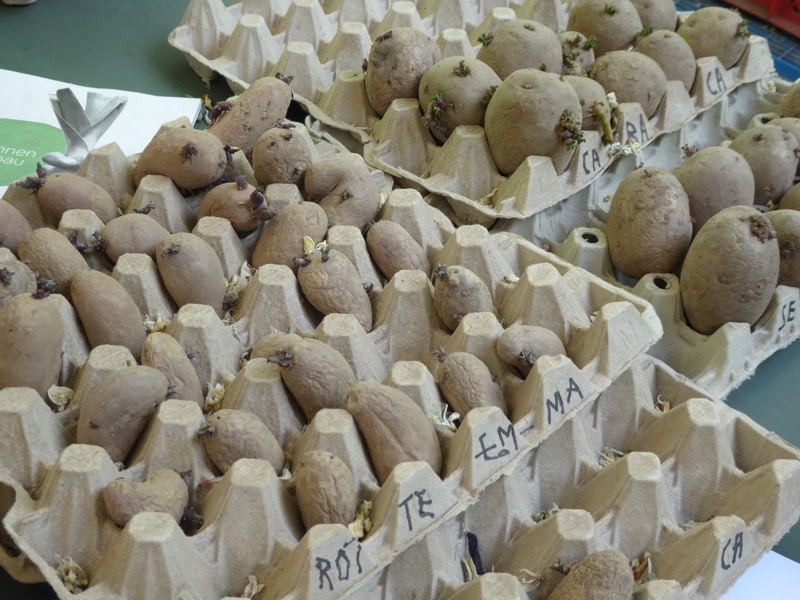
Potatoes can already be pre-germinated for sowing. A bright place at around 10 degrees is ideal. In warmer regions, they can be planted outdoors towards the end of February if the tender shoots are protected from frost with a bell or fleece, in colder regions from the beginning of April.
Great wild plants with beautiful, insect-friendly flowers can be sown on the balcony in February (until June):
I have marked my favorite proven wild plants for containers in bold. Location, flowering period, flowering color, size/height/spacing, perennial/biennial or annual, information on sowing, germination period, use/edibility and which animals use them (1TP5 animal plants) can be found in the link.
Yellow flowers:
- Common toadflax
- Sweet clover
- Black mullein
- Magnificent mullein
- Large-flowered mullein
- Usury flower
- St. John’s wort
- Common piglet weed
- Dyer’s dog chamomile
Blue and purple flowers:
- Persistent flax
- Common chicory
- Common viper’s bugloss
- Forest forget-me-not
- Long-leaved speedwell
- Grand Prize of Honor
- Gamander speedwell
- Speedwell
- Round-leaved bellflower
- Peach-leaved bellflower
- Nettle-leaved bellflower
- Field bellflower
- Large-flowered brown allium
- Common brown allium
Pink and red flowers:
- Red campion
- Mauritanian mallow
- Night violet
- Carnation cinquefoil
- Ruprecht’s weed
- Carthusian pink
- Nodding thistle
- Tufted carnation
- Common loosestrife
- Meadow widow flower
- Meadow foamwort
- Common water azalea
- Red clover
- Seed sparrow
- Pitch carnation
- Meadow knapweed
- Corn cockle
- True motherwort
White flowers:
- Meadow yarrow
- Meadow daisy
- Middle plantain
- White sweet clover
- Pointed plantain
- Greater sorrel
- Feverfew
- Spoonwort
- White campion
- Nodding cinquefoil
- Common cuckoo flower
- Real catnip
- Roman chamomile
- True chamomile
- Common shepherd’s purse
- Daisies
- True marshmallow
- Wild carrot
Seed-resistant insect-friendly herbs for pre-cultivation from February/March
- Lemon tagetes
- Lemon basil
- Cinnamon basil
- Lettuce leaf basil
- Red basil
- Genovese basil
- Small meadow button
- Genuine thyme
- Wild rocket
- Wild oregano
- True fennel
- Chives
- Curly parsley
- Flat-leaf parsley
- Genuine coriander
- Curly chervil
- Genuine chervil
- Red garden milkweed
- Green garden melilot
- Yellow garden mint
- Dill
Sifting the seed
Look through the old seed stocks, buy or order new seeds (Recommendations for organic seed) and make garden plans for the coming balcony gardening season! When planning, let your personal preferences guide you — what do you like to eat, what do you like to smell, what is good for insects? Variety is important — lots of different plants, lots of unfilled flowers with a rich supply of pollen and nectar from March until the frost. As a balcony gardener, don’t let yourself be confused or put off by the abundant opportunities for crop rotation and mixed cultivation, which I often experience because nobody wants to do anything wrong. Variety is important!
Organic seeds and organic plants are guaranteed to be free of chemicals and therefore non-toxic for us, insects and other animals. The plants grow healthier, more naturally and more sustainably. Before you order online, perhaps you can regional buy good quality. You can find online suppliers here.
February is the time for shrubs on the balcony
Woody plants of all kinds can still be pruned on frost-free days until the end of February.
New shrubs can be planted during the dormant period until they sprout (early February to mid-May), container plants all year round. Aronia berry, rock pear, cornelian cherry and cherry are particularly suitable for use in containers. Columnar apple trees Proven. The best way to buy fruit trees is bare root from a professional fruit nursery. They can advise you on the variety that is suitable for your climate and cultivation in large containers. Variety and rootstock/rootstock (slow-growing) make a big difference to success. Our experts Conrad Amber and Dr. Sonja Schwingesbauer presented ourselves for the 6th Online Organic Balcony Congress March 2021 Can you plant animals? lists of which woody plants are suitable for the extreme balcony location. In September 2024, the Organic Balcony Congress was dedicated to Shrubs in tubs. A List with 105 woody plantswhich have proven themselves in pot cultivation.
Here is a good source for bare-rooted shrubs in Demeter quality, es kann nie genug Beeren geben.
The trees and shrubs can be planted from the middle of the month with Worm humus from the worm bin which has a fertilizing effect and promotes soil life.
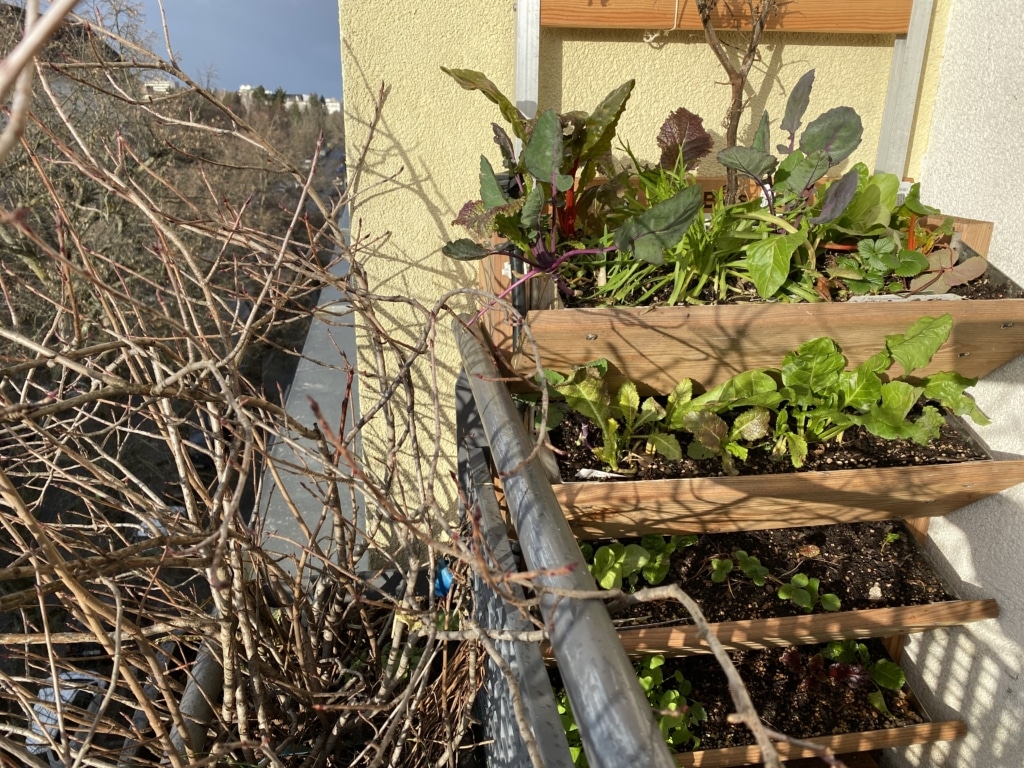
Insect nesting aids
Insect nesting aids should be built and installed now.
» Building instructions for effective nesting aids for wild bees — NABU
» Sources of error when building insect nesting aids
Lovingly handcrafted, well thought-out, pretty nesting aids are available here to acquire.
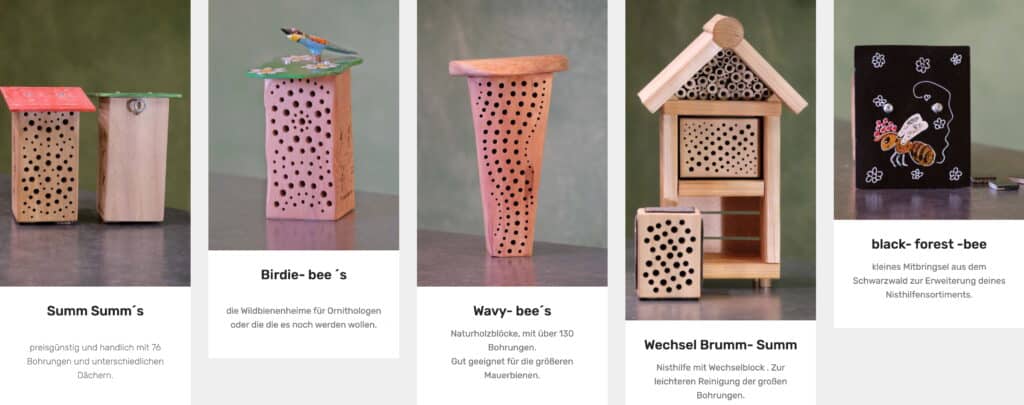
Have fun with the planning. Experience has shown that the tried and tested Online providers early ordering is an advantage, otherwise there is a risk of long waiting times before delivery. If you feel the tingling in your hands and want to watch plants grow — think of growing Microgreens and sprouts on the kitchen table and windowsill. The appearance is captivatingly beautiful and fresh green, and the ingredients are particularly good for us in the cold season. I have been ordering the best organic sprouting seeds and accessories for years here (First order with 10% discount with code Bio-Balkon2025).
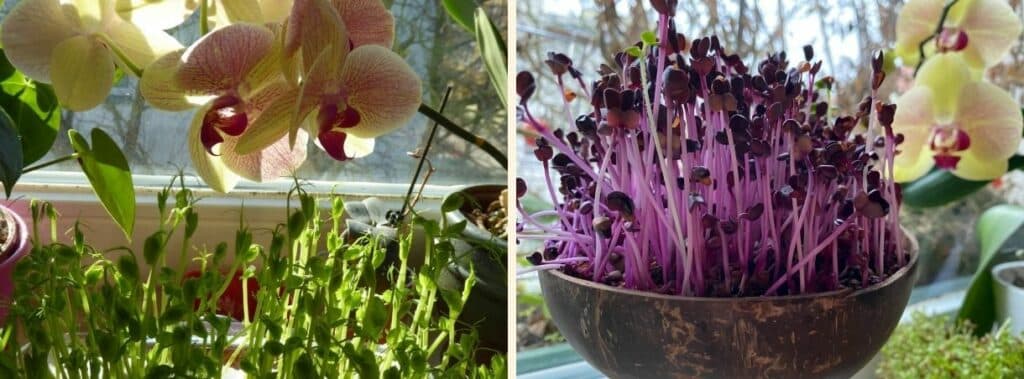
Order organic dahlias
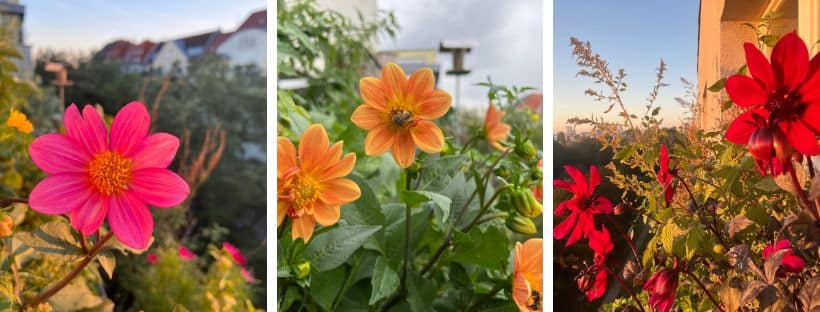
Dahlia tubers in organic quality can be ordered from the smart Robert Heemskerk. There is a large selection useful for bees unfilled flowers with open heart. If you order for at least € 25, you will receive 5 € discount and as Bonus one tuber on top. The Discount code biobalkon25 is valid until 31.12.25. Shipping for dahlia tubers starts from mid-March to the end of May at the right time for planting. Do not plant until after the last night frost or plant in a container indoors from March for early flowers from June. The long flowering period until the frost is great, the luminosity is special, as the photos show. I even grow the low varieties on the windowsill in a 60 cm balcony box with a water reservoir.
Keep your feet still, don’t cut anything down
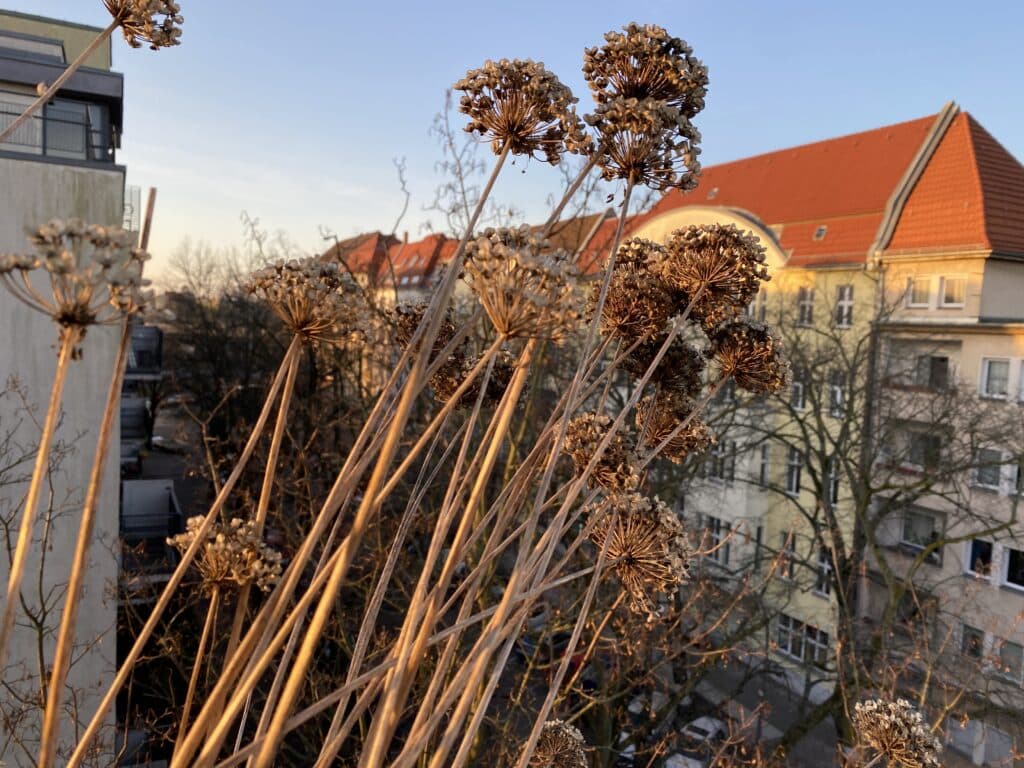
As is the case throughout the fall and winter, leave dead stems standing because they are important habitats for insects. So keep your feet still and look forward to the season! People used to clean all their pots at this time of year. But that’s not necessary, it was probably mainly to keep gardeners busy in winter.
Harvest in February
As the days get warmer and longer, you will notice that the plants start to make a growth spurt. They can be harvested towards the end of the month: In addition to leafy vegetables such as Swiss chard, kale, spoon cabbage, winter cress, chopped garlic, chopped celery and Asian salads, the frost-hardy culinary herbs rosemary and sage can also be harvested. If you have planted Jerusalem artichokes, you can dig them up now and leave a tuber in the pot for the next season. From our native wild plants sorrel, mugwort, Dandelion, goutweed and nettles young shoot tips can be harvested.
Sources of supply
Our Green card with non-toxic organic (producing) nurseries and organic balconies
Discounts and recommendations for the organic balcony movement









15 Responses
Dear Birgit,
From the first organic balcony conference I attended with you, I remember you saying that every balcony should have a tree. At the time I thought “well, my balcony is so long and narrow and so high up”. But you managed to top all that. Last year we got a pergola and planted a young vine that grew well and had great grapes. This spring it can move into a larger tub. Last week we added a dwarf apricot and the nectarine is not (yet) available — two varieties that have a hard time in our garden because of the soil. So we are creating a natural sunshade. Our project for February is to get the “forest garden” on the balcony on the right track.
Dear Heike, I look forward to your regular reports in our group. Trees on balconies work and are worthwhile. I think it would be good if you wrote about your experiences and plans in our group. Kind regards Birgit
Thank you for all the ideas on how to bridge the gap until spring actually arrives. Even though my “green fingers” are already tingling, I prefer to wait a little longer. I like the quiet time when nature takes a deep breath before it really gets going 😉
Dear Valerie, I’d love to. You can feel your fingers and body tingling, spring is already in the starting blocks. Nature is taking its course. Best wishes from rainy Berlin Birgit
Dear all, I will place the “hanger for the staircase” in my car on one of the rear side windows. I’ve done that before (in a different way) and I know that it’s an eye-catcher!!! Apart from that, I’m really looking forward to when things really get going again. I have 1 crocus blooming on my balcony so far + already: the lungwort !!!
Kind regards from Petra
Dear Petra, that’s a great idea. Super. Thank you for that. My lungwort is nowhere near ready yet, only tender tips are peeking out. Kind regards Birgit
Yesterday I collected the first wild wild garlic and it is already showing on my balcony.
Dear Birgit, are all your shrubs now getting worm humus, including chokeberry and rock pear?
Best regards
Sun
Dear Sun, if the time suits me, all my shrubs and pots get a spring start fertilization at the end of February, in March. When I have time, if it’s not too cold. Kind regards Birgit
To my great delight, there are a few small Artemisia annua plants in my balcony boxes
came up. I was in India for 6 months and the Artemisia (my favorite plant) has been a great help to me.
Welcome home.
Can’t wait for the Bio Balkon Congress to start!
Many thanks Birgit and best regards from Munich
Abhaya
Dear Abhaya, that’s great. I haven’t seen any yet. I’m currently dominated by wall cinnamon, I can see young plants of it everywhere. I hope that Artemisia annua will also come up, you seem to be particularly early. But no apartment, if it welcomes you after such a beautiful time in India, that’s fine. Kind regards Birgit
I’m curious to see if my balcony boxes still don’t need a change of soil this season. Unfortunately, I don’t have any worm humus, my bokashi is always moldy and I only collected my compost (laundry garbage can in the garden) this year, so it’s not ripe yet. I put sheep’s wool under the soil 2 years ago when I set up the boxes. I wonder if that will be enough “food” for my perennials this year…?
Dear Daniela! The plants will show you. If they develop poorly, remain stunted, get yellow leaves, you should fertilize them. Simply observe the plants. Sheep’s wool decomposes over 6–12 months, depending on the temperature, existing soil life and type of plant. You will notice it. Kind regards Birgit
Anyway, I’m really excited about the “Tiny wild north-facing balcony” theme, because that’s exactly my situation. 🙂
Dear Daniela! This is an outstanding contribution. I was amazed. Patricia also gave a great presentation. Kind regards Birgit